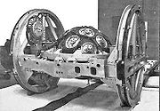
Orange Herald
Encyclopedia
Technical
Orange Herald was a fusion boosted British fission nuclear weapon, comprising a U-235Uranium-235
- References :* .* DOE Fundamentals handbook: Nuclear Physics and Reactor theory , .* A piece of U-235 the size of a grain of rice can produce energy equal to that contained in three tons of coal or fourteen barrels of oil. -External links:* * * one of the earliest articles on U-235 for the...
primary surrounded by lithium deuteride. 'Herald' was suitable for mounting on a missile, utilizing 117 kg of U-235. However, Britain's annual production of U-235 was only 120 kg at this time, which would have made such weapons rare and very expensive.
Two versions were designed - an "Orange Herald Large" with an overall diameter of 39 inches (1.0 m), and an "Orange Herald Small" with overall diameter of 30 inches (0.75 m).
The Orange Herald Small version was tested once, yielding 720 kT
KT (energy)
kT is the product of the Boltzmann constant, k, and the temperature, T. This product is used in physics as a scaling factor for energy values in molecular-scale systems , as the rates and frequencies of many processes and phenomena depend not on their energy alone, but on the ratio of that energy...
of explosive power on 31 May 1957, during the Grapple 2/Orange Herald
Operation Grapple
Operation Grapple, and operations Grapple X, Grapple Y and Grapple Z, were the names of British nuclear tests of the hydrogen bomb. They were held 1956—1958 at Malden Island and Christmas Island in the central Pacific Ocean. Nine nuclear detonations took place during the trials, resulting in...
tests on Malden Island
Malden Island
Malden Island, sometimes called Independence Island in the nineteenth century, is a low, arid, uninhabited island in the central Pacific Ocean, about in area...
in the Pacific. Orange Herald remains the largest fission device ever tested.
It is thought that the fusion boosting failed to increase the yield. A higher compression but smaller fission pit
Pit (nuclear weapon)
The pit is the core of an implosion weapon – the fissile material and any neutron reflector or tamper bonded to it. Some weapons tested during the 1950s used pits made with U-235 alone, or in composite with plutonium, but all-plutonium pits are the smallest in diameter and have been the standard...
American weapon, the Mark 18 Super Oralloy Bomb
Mark 18 nuclear bomb
The Mark 18 nuclear bomb, also known as the SOB or Super Oralloy Bomb, was an American nuclear bomb design which was the highest yield fission bomb produced by the US. The Mark 18 had a design yield of 500 kilotons...
, had a yield of 500 kilotons from a pit with slightly over 60 kilograms of highly enriched uranium, around 8 kilotons per kilogram of uranium, about the practical maximum 50% fission yield efficiency for very large or very highly boosted fission weapons. Even with less compression, the larger 117 kg pit of HEU in the Orange Herald Small should have had a roughly similar efficiency - the observed 720 kiloton yield equals over 6 kilotons per kilogram of uranium.
Orange Herald was the first British nuclear device to use an external neutron source.
Britain rushed the development of these predicted-megaton
TNT equivalent
TNT equivalent is a method of quantifying the energy released in explosions. The ton of TNT is a unit of energy equal to 4.184 gigajoules, which is approximately the amount of energy released in the detonation of one ton of TNT...
class weapons because in 1955 it seemed that atmospheric testing could soon be outlawed by treaty. As a result, the UK wanted to demonstrate its ability to manufacture megaton class weapons by proof-testing them before any legal prohibitions were in place.
It is believed by some that the large requirements of fissile material that Orange herald needed was a major cause of the Windscale fire
Windscale fire
The Windscale fire of 10 October 1957 was the worst nuclear accident in Great Britain's history, ranked in severity at level 5 on the 7-point International Nuclear Event Scale. The two piles had been hurriedly built as part of the British atomic bomb project. Windscale Pile No. 1 was operational in...
. It was unpopular with the scientists who worked on the project. One of the workers in the British nuclear program is quoted as saying "I thought that Orange Herald was a stupid device. It wasn't elegant, it was a dead end design and couldn't be taken any further". This is the major thesis of a notable BBC documentary on the topic of the fire Windscale: Britain’s Biggest Nuclear Disaster.

